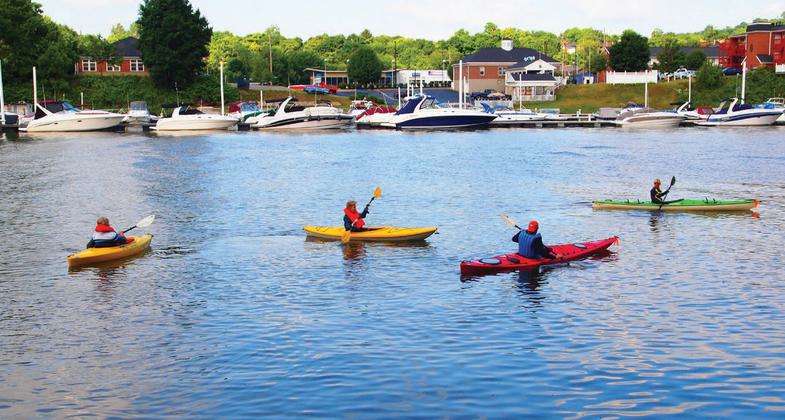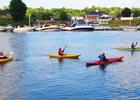Ohio River Water Trail
check with the trail manager for updated details before visiting.
Ohio River Water Trail
Nonprofit
Water Trail (other)
- Length
69 miles
- Elevation Gain
--
- Route Type
out & back
- Length
69 miles - Elevation Gain
-- - Route Type
out & back
The Ohio River Water Trail (ORWT) extends from the Three Rivers Water Trail in Pittsburgh, PA to Newell, WV, and East Liverpool, OH. The 69-mile ORWT includes thirty-three-miles of the Ohio River from Dashields Dam at milepost 13, downstream to Newell, WV at milepost 46.0, sixteen miles of the Little Beaver Creek to Beaver Creek State Park, three miles of the Beaver River to the Townsend (Fallston) Dam, and four-miles of the Raccoon Creek.

Ohio River Water Trail Beaver River kayaking.

Little Beaver Creek, Ohio River Water Trail


ORWT Little Beaver Creek Guided Tour

Little Beaver Creek Rapids


Location: From the Three Rivers Water Trail in Pittsburgh, Pa to East Liverpool, Ohio and Newell, WV
- States: Ohio, Pennsylvania, West Virginia
- Counties: Allegheny, Beaver, Columbiana, Hancock
- Cities/Townships: 21
The Ohio River Water Trail (ORWT) is a tri-state blueway system that extends from Crescent Township, Pa, and Leetsdale, PA to Newell, WV, and East Liverpool, OH. The 69-mile ORWT includes forty-six-miles of the Ohio River from Pittsburgh, downstream to Newell, WV at milepost 46.0, sixteen miles of the national scenic Little Beaver Creek to Beaver Creek State Park, three miles of the Beaver River to the Townsend (Fallston) Dam, and four-miles of the Raccoon Creek.
The ORWT is part of the Pennsylvania water trail system, connecting to the Three Rivers Water Trail, the Youghiogheny River Trail, and the Kiski-Conemaugh River Water Trail all of which are National Recreation Trails.
To address the growing popularity of blueways and their rising importance for their recreational, educational, historical, and economic potential, the Ohio River Trail Council (ORTC), partnered with the National Park Service RTCA, the Pennsylvania Environmental Council, Pennsylvania Boat and Fish Commission, U.S. Army Corps of Engineers, Port of Pittsburgh Commission, Beaver County Recreation and Tourism Department to develop the Ohio River Water Trail System that has 21 access points along 32 riverfront communities in Ohio, Pennsylvania, and West Virginia.
The municipality landings contain such facilities as ramps, safety information, interpretive signs, bike racks, and canoe/kayak racks. The detailed ORWT Map and Guide offer safety and boating information, Leave No Trace principles, rules of the waterways, potential dangers, recommended equipment, and fishing opportunities, while identifying many amenities, points of interest, and multiple tours along the water trail, parking, restroom, and food service information. The guide can be viewed and downloaded at www.water.ohiorivertrail.org/index.php/en/ohio-river-water-trail-map-guide.
The ORWT is promoted and partially maintained by the ORTC. Management of the access points falls principally to the municipalities. The mission of the ORTC is to improve access, increase awareness and engagement with the Ohio River and its tributaries through activities and stewardship.
The blueway helps people discover our hometown river with wonderful family-friendly recreational activities such as fishing, boating, kayaking, canoeing, paddleboarding, and wildlife viewing. The trail encourages healthy living through increased physical activity among our citizens while improving public health and wellness.
The blue trails connect us to our heritage as well as enhance our sense of community identity and pride especially as we highlight our local historic and natural resources.
The ORWT is home to Phyllis and Georgetown Islands, which are the two easternmost islands of the Ohio River Islands National Wildlife Refuge. The refuge works to conserve the"wild" Ohio and protect migratory birds, freshwater mussels, and other wildlife along with the habitats native to the Ohio River.
Regrettably, both islands have experienced severe losses of the land base due to erosion. At the turn of the 20th century, Beaver County had six islands dotting the Ohio River between Aliquippa and Georgetown, now only Phillis and Georgetown remain. The islands are examples of riparian forests and include hardwoods and plant life that depend on periodic flooding to regenerate. Only about 35 percent of the Ohio Valley's riparian forest survives.
Fortunately, the Fish and Wildlife Service is collaborating with the U.S. Army Corps of Engineers, Pittsburgh District, to implement a comprehensive bank protection project to protect these islands.
For thousands of years, Native Americans formed numerous civilizations along the Ohio River and used it as a major transportation and trading route. Its waters connected many settlements where they fished and hunted on the islands and banks of the Ohio River.
Phillis Island is one of the oldest American Indian sites in the Ohio River Valley. Archaeological studies of Phillis Island unearthed artifacts from the Paleo-Indian, Archaic, and Woodland Periods. Excavations at the nearby Leetsdale site also revealed evidence of occupation during the Early Woodland period and found signs of encampments throughout the Middle, Late, and Transitional Archaic Periods. In addition, Native American artifacts were preserved in floodplain deposits dating back 6,800 years.
Located near Georgetown Island are the Smiths Ferry Indian Rocks or petroglyphs created from 1200-1750 A.D. by the Monongahela People on a flat stratum of smooth, massive sandstone that extends out over one hundred feet into the Ohio River. Unfortunately, most of the site has been submerged by water when the Ohio River Lock & Dams were constructed for modern navigation.
The first Europeans to view the Ohio River was the 1669 Robert de La Salle-led expedition. La Salle, Frenchman, named the river La Belle Riviere. Ohio is an Iroquois Indian name, "Oheo", which traditionally is interpreted to mean "Beautiful River" agreeing with the opinion of the French. In late 1753, a young George Washington, only 21 years old, visited the Native American riverside village called Logstown along the Ohio River to warn the French away from the Ohio Valley and assert the claim of the British. The dispute erupted into violence and led to the French & Indian War.
The ORWT is part of the water route navigated by Meriwether Lewis, who led the Corps of Discovery, 11 men on a keelboat from Pittsburgh, Pennsylvania on August 31, 1803. On September 3, 1803, they stayed overnight in the Georgetown Island area. A boat had sprung a leak and Captain Lewis bought a canoe, which also leaked. Lewis spent part of the day drying out his supplies and repairing the canoe.
During the Industrial Revolution, coal transported via the Ohio River powered the transformation of the United States from an agrarian society into one of the largest industrial powers in the world. Beaver County grew rapidly after 1900 with the establishment of steel mills along the Ohio River, and much of the working force was engaged in steel production until the contraction of the steel industry in the late 1970s and early 1980s. The ORWT corridor is part of the Rivers of Steel National Heritage Area, which is oriented around the interpretation and promotion of the region's steel-making heritage. The Rivers of Steel Heritage Corporation conserves, interprets, and develops historical, cultural, and recreational resources throughout western Pennsylvania and promotes renewed connections between the region's residents and outdoor recreation.
Today, Pittsburgh is the second busiest inland port in the nation and the 17th busiest port, of any kind, in the nation. More than $9 billion worth of goods moved along the waterways through the Port of Pittsburgh District and 45,000 jobs in southwestern Pennsylvania are dependent upon the waterway transportation system.
Support for these special places has increased as people spend time exploring. Through them, we create a valuable legacy that honors the past, enriches the present, and provides a precious gift to future generations. The ORWT serves as an incredible historical national legacy for future generations.
Accessibility Information
No text provided.
Allowed Uses:
Boating, motorized Boating, human-poweredOther Activities
- Camping
- Fishing
- Heritage and history
- Wildlife viewing / observation
Public Contact
Vincent TroiaOhio River Trail Council
1100 Pennsylvania Av
Monaca, PA 15061
[email protected] • 7247282625
More Details
- Elevation (low): --
- Elevation (high): --
- Elevation (cumulative): --
- Part of a Trail System? No
- State Designations: PA State Water Trail
- Surface (primary): Water, slow moving
- Surfaces (additional): Water, calm
- Tread Width (average): 0"
- Tread Width (minimum): 0
- Running length (minimum): --
- Tread Grade (average, percent): --
- Tread Grade (maximum):
- Running length (maximum): --
- Cross-slope (average, percent): 0
- Cross-slope (maximum): --
- Running length (maximum): --
- Certified as an NRT
Jun 3, 2015

